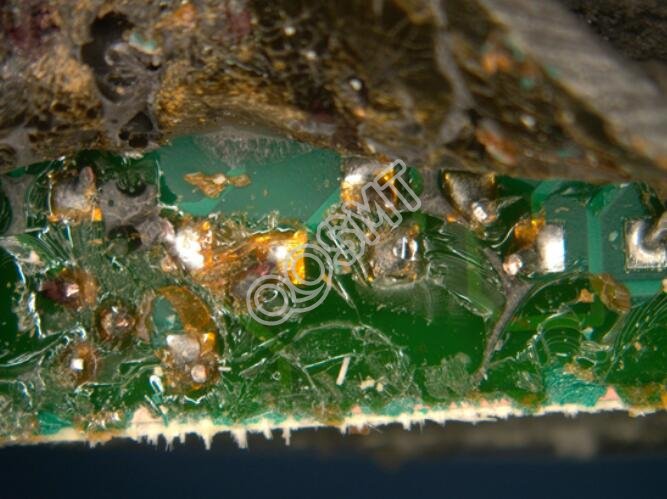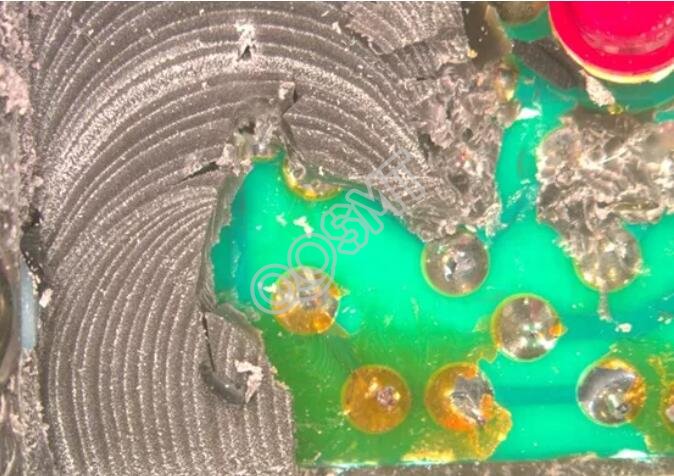Why does flux residue cause electronic failure?
Oct 17, 2021


Flux application
There are four main methods of welding:
- Surface mount reflow soldering (SMT)
- Full board wave soldering
- Selective soldering
- manual welding
Each method leaves a different degree of risk, resulting in the presence of flux residues, which may lead to failures. The SMT soldering method has the lowest risk, while the use of liquid flux has the highest risk. Understanding the application process, the ingredients in the flux and the recommendations of the flux manufacturer can greatly improve the reliability of electronic devices.
What is flux?
Flux is an acidic mixture of chemicals used to remove metal oxides during the soldering process to achieve good solder bonding. You may hear the terms "low activity" and "high activity" to describe whether the flux residue after soldering is at risk of causing cleaning-related failures. However, from a chemical point of view, these terms are not precisely defined, and there is no single standard analysis or chemical test to classify flux residues as "low activity" or "high activity". This is because failures caused by leakage current not only depend on the chemical properties of the flux and the amount of flux applied, but also the electrical sensitivity and use environment will have a significant impact on reliability.
Most of the liquid flux ingredients used in wave soldering, selective soldering and manual soldering include:
- Solvent
- Activator
- Film forming agent
- Additives
Activators and film formers have a greater impact on the risk of failure than other factors.
Activator
No-clean fluxes usually use weak organic acids (WOA) as activators. Some weak acids are glutaric acid, succinic acid and adipic acid. The presence of activators puts flux residues at risk because they are acidic, but they are necessary to obtain good solder joints. They react with metal oxides to form metal salts, promote wetting, and form metallurgical bonds after the salt dissolves. The acid is gradually consumed during the soldering process. The acid may be used in other reactions that have pollution or decomposition reactions, but these reactions are not consistent, depending on the chemical properties of the flux and other factors that are not easy to control. Most weak organic acids basically do not evaporate at the soldering temperature. Therefore, it is important to adjust the amount of activator (and flux) to the minimum required for good soldering.

Film forming agent
Film-forming agents are high-melting chemicals that are insoluble in water. After soldering, they formed most of the visible residue. They act to contain activators and prevent them from dissolving in water. The "low solids" flux formulation contains almost no film formers and almost no visible residues. In theory, more film-forming agent can reduce the risk of failure, but it will also make the components look dirty. The most common ingredients of film forming agents are rosin, chemically modified rosin and synthetic resins.
Solvent
The main function of the solvent is to dissolve all the ingredients in the flux, making it a uniform viscous liquid, easy to use. Sometimes, several solvents with different boiling points can be used to ensure that the physical properties of the different temperature stages of the welding curve are maintained, and they must be completely evaporated during the welding process. If the solvent is present in the flux residue, it will increase the risk of failure. It is important to ensure that the flux is only applied to the areas of the component that are exposed to the peak soldering temperature. During the wave soldering process, the flux can flow through the holes to the top side of the component, or under the protective layer, so that it will not appear at high temperatures. Hand-applied liquid flux may be particularly problematic, and human factors have a great influence.
additive
Additives usually make up only a small part of the flux. They can be plasticizers, dyes or antioxidants. Although manufacturers may add chemical ingredients to help improve reliability, the residual impact is minimal.

Flux application
- There are many ways to apply flux, the most common ones are:
- Flux in solder paste for surface mounting
- Liquid flux for wave soldering or selective soldering
- Liquid flux for manual soldering
- Flux in welding wire or electrode
Since the amount of flux used is important, these different application processes will bring about different levels of risk of cleaning-related failures. The risk of solder paste flux is the smallest because a screen or printer is used to control the amount of solder paste flux applied. There are few failures caused by reflow solder residues in surface mount (QFN may be problematic). The use of liquid flux brings greater risks. Spraying can use more flux than other processes. If not optimally controlled, the process may apply more flux than necessary, leaving more acidic residues, creating more favorable conditions for potential chemical corrosion reactions, and liquid flux may also It will flow to parts that are not under high temperature. It may also be difficult to control the amount of flux applied during manual soldering. Excessive flux may flow under nearby components, which greatly affects the level of manual skill.
Failure analysis technology during or after assembly
Although there is no comprehensive risk assessment tool, there are some risk assessment methods that can successfully reduce the risk of failure.
Usually during the SMT cleaning operation, the electrical resistivity of the solvent extract (ROSE) is used to indirectly determine the cleanliness of the flux residual ions. The numerical results help to ensure a qualified solder and cleaning process. Ion chromatography IC has become a commonly used technique to identify common ions on the surface of SMT and provide a direct measurement of the content of the weak organic acid activator remaining after soldering. It is especially important for liquid flux, because the amount of flux applied can be easily detected, and different ion chromatography methods produce different results. The complete module immersion test is the average ion concentration detected on the entire module surface, while the local extraction technology can measure the ion concentration in a small range. The disadvantage of all ion chromatography methods is the lack of pass/fail standards; each welding process, design, and environment will affect the yield. Our experience allows us to know the average number of ions and the number of bad
